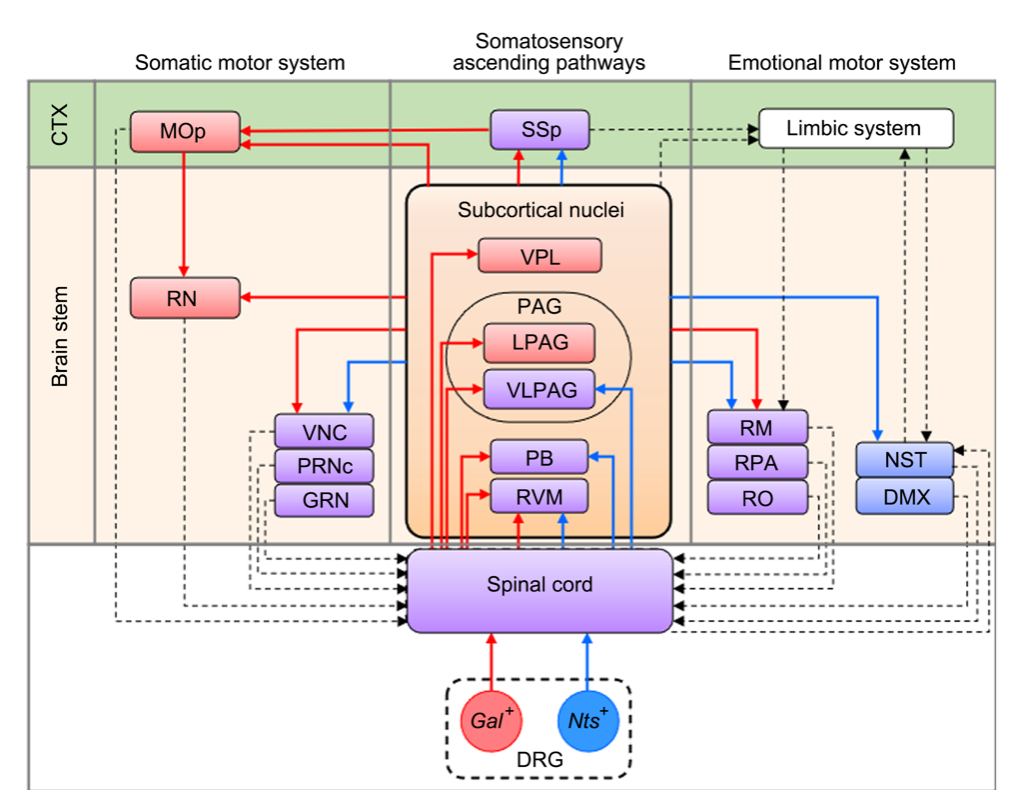Pain and itch are distinct sensations arousing evasion and compulsive desire for scratching, respectively. Cutaneous signals of noxious or pruritic stimuli can be detected by free nerve endings of the small-diameter somatosensory neurons located in the dorsal root ganglion (DRG). Our previous work on single-cell RNA-sequencing of DRG neurons revealed that Galanin (Gal) could be used as a marker to separate the peptidergic nociceptors from other small-diameter DRG neurons, and a subset of pruriceptors expressing natriuretic peptide B (Nppb) could be also marked by the genes encoding somatostatin (Sst) and neurotensin (Nts) (Li et al., Cell Res. 2016; Wang et al., Cell Res. 2021). Both Gal+ and Nppb+ DRG neurons project unmyelinated C fibers to the lamina I and outer lamina II in the dorsal horn of spinal cord. It’s unclear whether they could invoke different neural networks in the brain.
This work entitled “Distinct neural networks derived from galanin-containing nociceptors and neurotensin-expressing pruriceptors” was published online in Proceeding of the National Academy of Sciences on August 10, 2022. Drs. Yan Chen, Yuran Song, Huadong Wang and their colleagues, under the supervision of Drs. Xu Zhang and Changlin Li at the Guangdong Institute of Intelligent Science and Technology (GDIIST), reveal the distinct organization of neural networks derived from two types of DRG neurons -- one kind of polymodal nociceptors containing Gal and one type of pruriceptors expressing Nts, for processing pain and itch, respectively.
In this study, researchers used the type 1 herpes simplex virus H129 strain to trace the neural networks derived from Gal+ nociceptor and Nts+ pruriceptors. The DRG microinjection and immunosuppression were performed in transgenic mice to achieve a successful tracing from specific types of DRG neurons to primary sensory cortex. About one third of nuclei in the brain were labeled. More than half of them were differentially labeled in two networks. For the ascending pathways, the spinothalamic tract was absent in the network derived from Nts+ pruriceptors, and the two networks shared the spinobulbar projections but occupied different subnuclei. As to the motor systems, more neurons in the primary motor cortex and red nucleus (RN) of the somatic motor system participated in the Gal+ nociceptor-derived network, while more neurons in the nucleus of the solitary tract (NST) and the dorsal motor nucleus of vagus nerve (DMX) of the emotional motor system were found in the Nts+ pruriceptor-derived network. Functional validation of differentially labeled nuclei by c-Fos test and chemogenetic inhibition suggested the RN in facilitating the response to noxious heat and the NST/DMX in regulating the histamine-induced scratching. This work reveals the organization of neural networks in a DRG neuron type-dependent manner for processing pain and itch.
This work was collaborated with Dr. Fuqiang Xu’s team as well as Drs. Anan Li and Hui Gong’s team. This work was funded by the National Natural Science Foundation of China, the Special Fund for Science-Technology Innovation Strategy of Guangdong Province, the Strategic Priority Research Program of the Chinese Academy of Sciences, Science and Technology Commission of Shanghai Municipality, the Science and Technology Planning Project of Guangdong Province, Innovation Fund for Medical Sciences of Chinese Academy of Medical Sciences and Shenzhen Sanming Project.

Organization of neural networks derived from from Gal-containing nociceptor and Nts-expressing pruriceptors
Reference:https://www.pnas.org/doi/10.1073/pnas.2118501119


